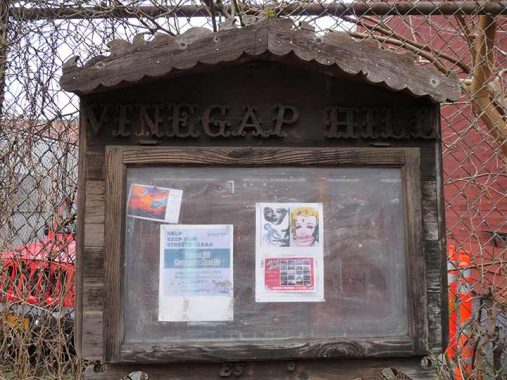
WHAT a surprise it was when, while pedaling around DUMBO on. a bicycle in the 1970s or 1980s, I took off east down Plymouth Street, navigating the Belgian blocked pavement and remaining Jay Street Connecting Railroad tracks. Eventually the brick and stone factory buildings fell away, giving way to a very small batch of tree-lined streets with storefronts (abandoned even then) and residences. The tall-steepled St. Ann’s Church was still there then. I was in the enclave called Vinegar Hill. I don’t think DUMBO was called DUMBO then; it was merely an extension of Downtown Brooklyn. The brick buildings, formerly home to shoe manufacturing, William Gair cardboard box factories and Arbuckle Brothers Yuban Coffee refineries, were then home to small manufacturing. DUMBO has become a bustling residential and business district, and its waterfront makes it a prime tourist locale. On December 31, 2023 I made my first foray into Brooklyn in over a year, as I had been hampered by a hernia and recurring sciatica that I hope won’t recur too often. I wandered DUMBO and Vinegar Hill, and will use the photos here eventually.
Vinegar Hill is about a four or five block square neighborhood located east of DUMBO and north of the Farragut Houses. It’s a charming little area marked by brownstone buildings and Belgian-block streets that haven’t yet been asphalted. Other than a couple of groceries and bodegas on Gold and Bridge Streets, and a couple of haute restaurants on Hudson Avenue, residents have to travel west to Brooklyn Heights, west to DUMBO, or south to Fulton Mall for amenities. It’s all that is left of a rather more extensive residential area; it was gradually decimated by the construction of the nearby Brooklyn-Queens Expressway and the Farragut Houses south of York Street in the 40s and 50s.
The story of how Vinegar Hill got its name is an unusual one. Vinegar Hill has been here since 1800, when a John Jackson purchased its land from the Sands brothers (for whom Sands Street is named). Jackson actually hoped to attract Irish immigrants in an era when Irish were otherwise unwelcome. He named his tract Vinegar Hill after the site of a fierce battle in the unsuccessful Irish rebellion of 1798. In Ireland, the name “Vinegar Hill” was an English transliteration of an Irish Gaelic term meaning “hill of the wood of the berries.” Vinegar Hill has also been known as Irish Town. Most of its residences were built between the late 1820s and the 1850s; the latter ones reflect the Italianate style.
As always, “comment…as you see fit.” I earn a small payment when you click on any ad on the site. Take a look at the new JOBS link in the red toolbar at the top of the page on the desktop version, as I also get a small payment when you view a job via that link.
3/12/24
